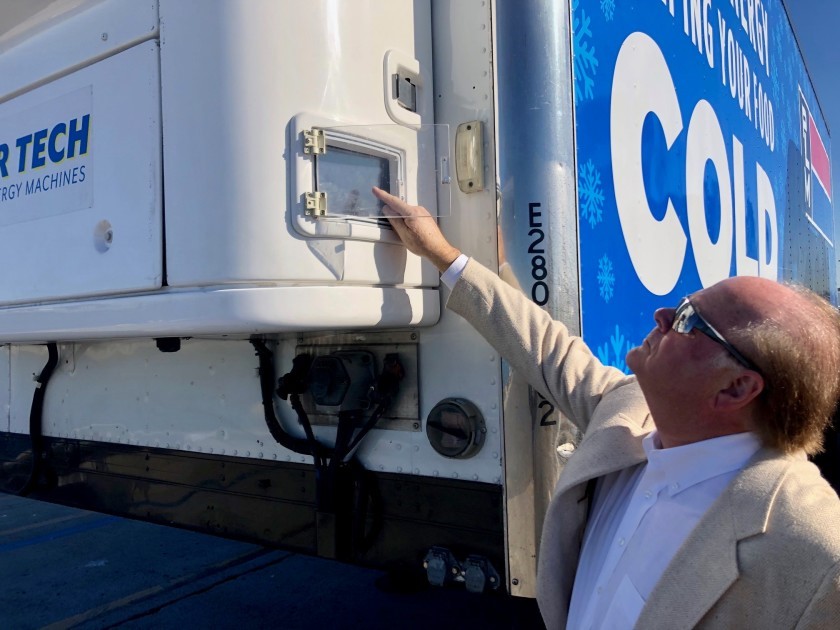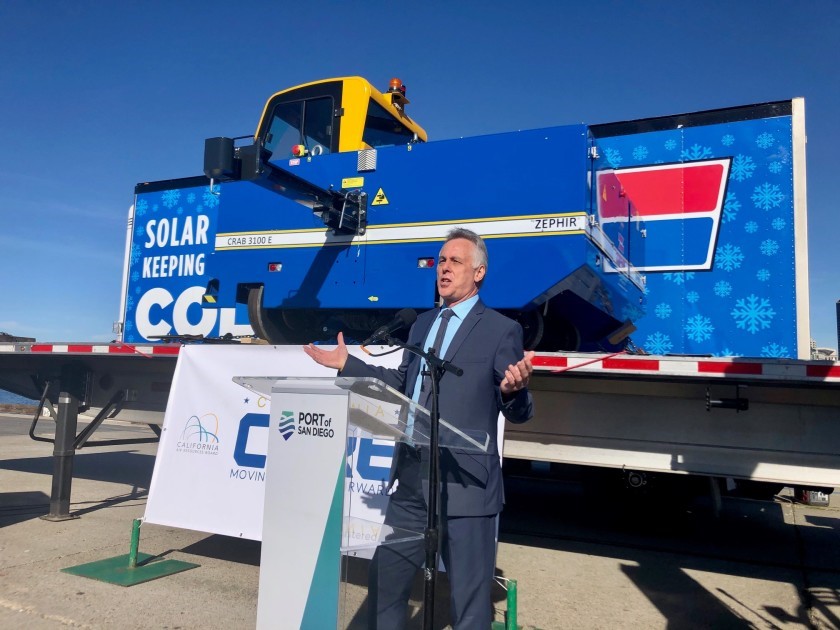News

Subscribe to our Quarterly Newsletter
Back to all News/Press Releases
California Launches $44 Million Voucher Program for Clean Energy Freight Equipment
*As written in the San Diego Tribune
Jan. 31 2020
Rob Nikolewski
Bill Van Amburg, executive vice president of Clean Transportation Technologies and Solutions, a group that administers the Clean Off-Road Equipment Voucher Incentive Project, speaks at the Port of San Diego on Friday. The project encourages businesses to switch from fossil fuel-powered equipment to zero-emissions by offering them vouchers to make up for the difference in price.
(Rob Nikolewski/The San Diego Union-Tribune)
California is spending billions on various programs to encourage the transition from internal combustion cars and trucks to electric vehicles. On Friday, though, the state unveiled another effort to reduce air pollution — a project aimed at persuading businesses at places like the Port of San Diego to replace their carbon-belching equipment with zero-emissions models.
Budgeted at $44 million this year, the Clean Off-Road Equipment Voucher Incentive Project, or CORE, offers companies up to $500,000 in vouchers to buy or lease cleaner energy versions of equipment such as forklifts, cranes, cargo loaders and terminal tractors.
The project also provides additional money if the businesses use the zero-emission equipment in communities that have high levels of air pollution.
Since fossil fuel-powered heavy equipment used by businesses in places like ports, warehouses, cargo airlines, rail yards and distribution centers costs less than zero-emission equipment, the vouchers look to eliminate the price difference.
“Right now, they are more expensive than their conventional counterparts so we’re trying to jump-start it with this program to take the (financial) risk out and have people put this equipment out faster rather than slower,” said Bill Van Amburg, executive vice president of Clean Transportation Technologies and Solutions, known as CALSTART, a nonprofit that will administer the program.
The neighborhood surrounding the Port of San Diego is one of 10 communities in California included in an air quality monitoring and cleanup program established after the passage of 2017’s Assembly Bill 617 to help areas most impacted by air pollution.
“Cleaner air means a better quality of life for our neighboring communities, our port side communities like Barrio Logan and National City,” said Rafael Castellanos of the Board of Port Commissioners.
The vouchers will be issued on a first-come, first-served basis. Van Amburg said he anticipates the Legislature allocating as much as $50 million to $60 million for CORE in coming years.
Is the project a good use of public funds?
“We’re making these investments in all parts of the state,” said State Sen. Ben Hueso, D-San Diego, who grew up in a neighborhood next to the port. “We have to do something to improve air quality here. It’s horrific. We have residential areas on both sides (of the port) and we have recreation here as well so we need to take aggressive measures to clean the air. They’re going to be expensive but people’s health is more important.”

Robert Koelsch, CEO of Advanced Energy Machines, turns on one of his company’s zero-emissions refrigerated storage units at the unveiling of California’s Clean Off-Road Equipment Voucher Incentive Project, also known as CORE, at a news conference at the Port of San Diego on Friday, Jan. 31, 2020.
(Photo by Rob Nikolewski)
Robert Koelsch, CEO of Advanced Energy Machines of Phoenix and Los Angeles, said electric equipment is generally three times more expensive than diesel-powered units. He said the vouchers will attract investment from hub businesses.
“We were hoping this would be here two years ago,” Koelsch said. “The whole fleet, the whole industry has been waiting. This is going to be a big success, no doubt about it.”
Koelsch turned on one of his company’s solar-powered refrigerated storage unit on display at the port.
“When I walk around a yard trying to integrate these electrics at existing diesel operations, I go back to my hotel room and I wipe the black off my face from the pollution, from the carbon,” Koelsch said. “Oh, it’s wicked bad.”
The vast majority of the state’s spending on zero-emission adoption measures has focused on passenger cars and trucks.
A review conducted last year by the Union-Tribune showed various state agencies have committed $2.46 billion in public funds — some of it already spent and the rest planned over a number of years — for programs aimed at luring drivers out of internal combustion-powered vehicles to electric vehicles and plug-in hybrids.
Former Gov. Jerry Brown in 2018 issued an executive order setting a goal of 5 million zero-emission vehicles in the state by 2030.
As of last October, California had 655,088 electric vehicles on the road. According to the Air Resources Board, the transportation sector accounts for the largest single source of greenhouse gas emissions in the state — 41 percent. In San Diego, the number is 54 percent.
